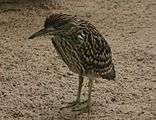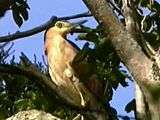Nankeen night heron
| Nankeen night heron | |
|---|---|
 | |
| Nankeen night heron visiting Melbourne Zoo | |
| Scientific classification | |
| Kingdom: | Animalia |
| Phylum: | Chordata |
| Class: | Aves |
| Order: | Pelecaniformes |
| Family: | Ardeidae |
| Genus: | Nycticorax |
| Species: | N. caledonicus |
| Binomial name | |
| Nycticorax caledonicus Gmelin, 1789 | |
| Subspecies | |
| |
| Synonyms | |
| |
The nankeen night heron (Nycticorax caledonicus) also commonly referred to as the rufous night heron, and in Melanesia as Melabaob, is a medium-sized heron. It is found in Indonesia, the Philippines, Papua New Guinea, Melanesia, and throughout much of Australia except the arid inland. A small colony has also established near Wanganui, New Zealand
Description
The nankeen night heron stands about 60 cm tall with a stooped appearance. It is not strictly nocturnal. It often feeds during the day, especially during wet weather. The bird is dependent on a diet of small fish, reptiles, insects and sometimes eggs. It can be seen around freshwater rivers, lakes, bulrushes, estuaries, harbors and in residential fishponds for goldfish.
Behaviour
Breeding
The species breeds in the period from September to April, building a nest platform out of sticks. It nests communally, near water. Two to five light green eggs are laid, with a 22-day incubation followed by a 42–49 day fledging period.
Widespread throughout its large range, the nankeen night heron is evaluated as Least Concern on the IUCN Red List of Threatened Species.
Various views and plumages
-

Juvenile perched on fallen tree
-

Juvenile visiting the little penguin enclosure at Melbourne Zoo
-

In flight, Lake Monger
-
Samsonvale Cemetery, SE Queensland, Australia
-

Adult at Fremantle Harbour
References
- ↑ BirdLife International (2012). "Nycticorax caledonicus". IUCN Red List of Threatened Species. Version 2013.2. International Union for Conservation of Nature. Retrieved 26 November 2013.
External links
| Wikimedia Commons has media related to Nycticorax caledonicus. |
| Wikispecies has information related to: Nycticorax caledonicus |

